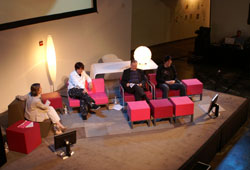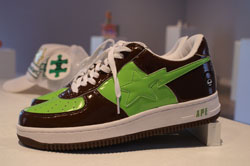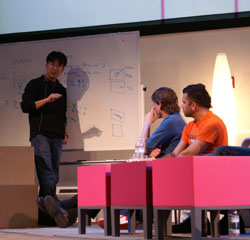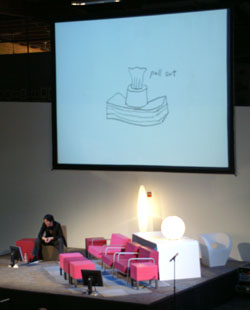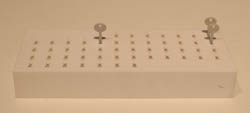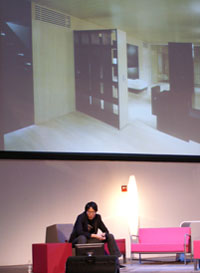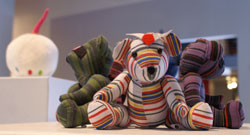
|
||
|
Portland art blog + news + exhibition reviews + galleries + contemporary northwest art
|
||
The Flow
From the day-long symposium on Tokyo design held during the last week of April to the exhibition of design objects currently on view in the Feldman Gallery, PNCA's exploration of trends in Japanese design and culture has set out to equip Portland's creative types with a new vocabulary and understanding that will provide fodder for their own practice. The association of Japan with cheap industrial fabrication and electronics has been overshadowed in the past few years by a reverence for Japanese culture, which has proliferated in both the United States and Europe in everything from art (Muarakami, Nara, Aoshima) to fashion (BAPE, Murakami for Louis Vuitton), music (Puffy Amiyumi) and style (designer toys). The Tokyo Flow symposium was not so much an attempt to rigidly define these trends as an opportunity to expose Portland audiences to these currents, identifying the ways of thinking and cultural context that inform Japanese design. A great deal of the work being exported from Japan has made an impact not because of its uniqueness or originality, but because it freely aggregates styles and influences—some have made comparisons to sampling in music—in a way that epitomizes modern urban experience. Other work captures the kind of minimal sereneness that derive from a rich aesthetic tradition. Combine that with the religious, cultural and historical forces that are also at play—and which perhaps still hold a certain exoticism for Western audiences—and it comes as no surprise that Japan has had such a pervasive influence on everything from pop culture to design. Taking a cue from the five "suitcase curators" who culled objects for Tokyo Object Flow, what follows is a sampling of what the symposium and the exhibition offered to Portland audiences:
Nigo, working through his label, A Bathing Ape, perfectly captures the way in which various facets of design and pop culture are channeled to create something that, while not particularly original, retains its design integrity and freshness. It works because of a combination of quality in fabrication, brilliant marketing and a style that somehow captures a lifestyle that is very much of this time. Interestingly, the BAPE shoe included in the exhibition was brought in by Nike's Howard Lichter, who aptly noted that one can't simply dismiss the derivative nature of the shoe because it adds up to something that's much more complex. BAPE's label was also extolled by W+K's Sudeep Gohil during one panel focusing on marketing and communications.
Hideshi Hamaguchi, displaying some adept diagramming skills at the white board, explained that perhaps this ability to absorb and adapt influences is inherent in the Japanese language itself. Hiragana, katakana and kanji are collectively comprised of thousands of characters. Katakana in particular, the system used for writing foreign words, both gives incredible flexibility for adapting new words, yet also retains their distinctness as foreign, non-Japanese words. The result is a high level of adaptability as well as an ability to live with ambiguity and an aptitude for reading into context more than meaning. Hamaguchi's suggestion to Americans? An increased use of visual language to exploit these same types of qualities.
The highlight of the symposium was key speaker Oki Sato, a young designer and principle of nendo, which has gained significant attention since its inception in 2002. Sato's work is best summed up in the simple drawings that serve as a starting point and an end point for each project. Like any good design, Sato's architecture, interiors and objects address function in a very elemental way. But Sato has the ability to insert open-ended questions or re-imagine one's relation to the spaces and objects he creates without making it seen like a self-indulgent exercise in design. Here, Sato explains the design for Kazan, a volanic tissue dispenser that acts like a paperweight rather than a container.
Sato's key calendar is yet another re-invention of a mundane object. A series of small keys are reconfigured each day to track the days and months, prompting the user to engage in a small ritual to "unlock" each day.
The Drawer House is an early work completed for Sato's own family. Tokyo's residential spaces are notoriously small and Sato, striving to find a solution to allow an efficient yet flexible use of space, conceived of a house in which different functions can simply be "pulled out" of the wall like a drawer. One space can be transformed into kitchen, office or bedroom by way of the built in furniture contained inside each tall "drawer." The house also included an indoor/outdoor bath that was literally wheeled on tracks to its desired position. Nendo has completed only a handful of architectural projects, but each one shares a similar use of one unifying theme. In another project completed for a new restaurant in Tokyo, yards of canvas became a cost-effective scrim to transform the outside, a primary material for everything from the interior surfaces to collateral material, and the inspiration for its name. A 2004 project, The Book House, transformed the entire exterior wall of a private residence into a bookshelf that would allow visitors to visit the library housed there while giving the owners a privacy within the interior spaces. The semi-transparent walls also allowed the shadows of the books to form a dynamic pattern of shadows, evidence of nendo's use of high technology materials for elegant solutions that go far beyond mere exercises in form. Sato described this as "technological poetry" that does not consider nature and technology as diametrically opposed.
Even when presented with more commercially based projects, Sato's ability to cut through to an essential experience is still present. In a project for a large exhibition based on the classic anime series Mobile Suit Gundam, which has a huge following both in Japan and worldwide, nendo created a "Gundam stripe." Based on the lines that trailed the character in the anime, the lines captured speed and defined a palette that graced everything from posters and products to the interior of the gift shop. Knowing that the otaku who visited would pay scant attention to anything but the actual series itself, nendo reached out to the other visitors, creating a visual element that was at once accessible but stayed true to the original series. Design Flow Tokyo • Through May 27 Posted by Katherine Bovee on May 16, 2006 at 9:30 | Comments (0) Comments Post a comment Thanks for signing in, . Now you can comment. (sign out)
(If you haven't left a comment here before, you may need to be approved by
the site owner before your comment will appear. Until then, it won't appear
on the entry. Thanks for waiting.)
|
| s p o n s o r s |
 |
 |
 |
 |
 |
 |
 |
 |
 |
 |
 |
 |
 |
 |

|
Site Design: Jennifer Armbrust | • | Site Development: Philippe Blanc & Katherine Bovee | |


